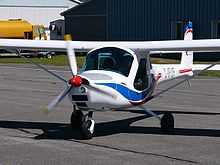Tricycle landing gear


Tricycle gear is a type of aircraft undercarriage, or landing gear, arranged in a tricycle fashion. The tricycle arrangement has one wheel in the front, called the nose wheel, and two or more main wheels slightly aft of the center of gravity. Because of the ease of operating tricycle gear aircraft on the ground, the configuration is the most widely used on aircraft.[1][2]
Several early aircraft had primitive tricycle gear, notably the Curtiss Pushers of the early 1910s. Waldo Waterman's 1929 tailless Whatsit was one of the first to have a steerable nose wheel.[3]
Tricycle gear and taildraggers compared
Tricycle gear is essentially the reverse of conventional landing gear or taildragger. On the ground, tricycle aircraft have a visibility advantage for the pilot as the nose of the aircraft is level, whereas the high nose of the taildragger can block the view ahead. Tricycle gear aircraft are much less liable to 'nose over' as can happen if a taildragger hits a bump or has the brakes heavily applied. In a nose-over, the aircraft's tail rises and the propeller strikes the ground, causing damage. The tricycle layout reduces the possibility of a ground loop, because the main gear lies behind the center of mass. However, tricycle aircraft can be susceptible to wheel-barrowing. The nosewheel equipped aircraft also is easier to handle on the ground in high winds due to its wing negative angle of attack. Student pilots are able to safely master nosewheel equipped aircraft more quickly.[2]
Tricycle gear aircraft are easier to land because the attitude required to land on the main gear is the same as that required in the flare, and they are less vulnerable to crosswinds. As a result, the majority of modern aircraft are fitted with tricycle gear. Almost all jet-powered aircraft have been fitted with tricycle landing gear, to avoid the blast of hot, high-speed gases causing damage to the ground surface, in particular runways and taxiways. The few exceptions have included the Yakovlev Yak-15, the Supermarine Attacker, and prototypes such as the Heinkel He 178, the first four prototypes (V1 through V4) of the Messerschmitt Me 262, and the Nene powered version of the Vickers VC.1 Viking.
The taildragger configuration has its own advantages, and is arguably more suited to rougher landing strips. The tailwheel makes the plane sit naturally in a nose-up attitude when on the ground, which is useful for operations on unpaved gravel surfaces where debris could damage the propeller. The tailwheel also transmits loads to the airframe in a way much less likely to cause airframe damage when operating on rough fields. The simpler[citation needed] main gear and small tailwheel result in both a lighter weight and less complexity if retractable. Also, a fixed-gear taildragger exhibits less interference drag and form drag in flight than a fixed-gear tricycle aircraft whose nosewheel may sit directly in the propeller's slipstream. Tailwheels are smaller and cheaper to buy and to maintain, and manhandling a tailwheel aircraft on the ground is easier. Most tailwheel aircraft are lower in overall height and thus may fit in lower hangars. Tailwheel aircraft are also more suitable for fitting with skis in wintertime.[2]
References
- ↑ Crane, Dale: Dictionary of Aeronautical Terms, third edition, page 524. Aviation Supplies & Academics, 1997. ISBN 1-56027-287-2
- ↑ 2.0 2.1 2.2 Aviation Publishers Co. Limited, From the Ground Up, page 11 (27th revised edition) ISBN 0-9690054-9-0
- ↑ Waterman Whatsit
| ||||||||||||||